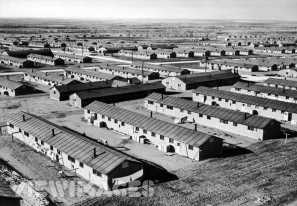Denver’s closed Civic Center Park has host of problems but crime statistics on par with recent years
Civic Center Park is officially closed. Anyone who bypasses the barricades and fencing around the national landmark between the Colorado Capitol and the Denver City and County Building risks being ticketed. It’s for the public’s own good, Denver leaders say.
In a news release announcing the temporary closure of the park and two adjacent properties, city officials said the areas “have become a hotspot for violence, crime, drug sales and substance misuse.” Scott Gilmore, deputy director of the city’s parks department, emphasized to CBS Denver that recent violent incidents were a driver of the shutdown.
But Denver police data doesn’t show an uptick in reported crime in Civic Center. Instead, crime levels have remained relatively stable in recent years, according to data analyzed by The Denver Post.
Denver police Chief Paul Pazen, in an interview, emphasized that the closure call was not made by his department.
“We’re not going to pretend we don’t have challenges over there,” he said of the downtown park. “Our focus is addressing the drug dealers and trying to hold them accountable for the harm they’re creating in the community.”
Crome statistics aside, city leaders have provided a laundry list of environmental and public health risks they say made a shutdown the only option. At a time when downtown Denver is struggling to rebound from the shock of the COVID-19 pandemic and there is an effort to rebrand and reinvigorate the eastern end of downtown near Civic Center, the closure is a period of short-term pain that will lead to a long-term improvement to civic life, leaders insist.
“There is a great deal of human waste and trash that is in the park. A lot of needles. A lot of discarded food,” Denver parks department spokeswoman Cynthia Karvaski said, adding that the food and trash are attracting rats. “We needed to come up with an operational plan that was sustainable and we weren’t able to do that with the park open.”
Civic Center long has had a reputation for being a hotbed for drug dealing and drug use. The refrain from city leaders ahead of the park shutdown had been that things were different this summer.
People openly shooting up and other things like aggressive — but not outright violent — behavior might not show up in crime reports but it impacts life in the park, said Eric Lazzari, executive director of the nonprofit Civic Center Conservancy.
For Lazzari, sitting at a table for lunch during a Civic Center Eats food truck event this summer and having another man sit at the same table and inject himself with an unknown substance hammered home how dire things had become.
“We are absolutely supportive of what the city did,” he said. “It was a necessary step. It had gotten to that point.”
Civic Center Park crime data
In its analysis, The Post looked at all crimes reported in the park, around the Pioneer Monument Fountain, the Wellington Webb Municipal Office Building and the major intersections that surround the park between Jan. 1, 2016, and Aug. 31, 2021. The area around the fountain and a strip of park space on the east side of the Webb building also have been shut down during the Civic Center cleanup.
There were 222 total crimes reported in that area in the first eight months of 2021, the data shows. That’s more than the 204 reported in that same time period in 2020 but fewer than the 284 reported in 2019. Between 2016 and 2020, the police department received an average of 323 crime reports in the first eight months of each year.
Violent crimes like assaults, robberies and homicides also have not changed substantially. Denver police recorded 20 such crimes through August of this year. That’s the same as the average count for the previous five years in that time period.
There had not been a homicide recorded in the park in the previous five years, but 2021 brought an end to that.
Jalen Adams, 28, was killed and two others injured in an Aug. 6 shooting at the park. That came after another man was shot and killed in the park on March 8.
Property crimes like theft and burglary have fallen, the data shows, though reports of drug sales and use have increased in the last three years.
Narcotics are the primary driver of crime and violence in the park, Pazen said.
Police previously had identified the area around the intersection of Colfax Avenue and Broadway as one of the five crime hotspots in the city in 2020.
But Pazen told City Council members at an Aug. 9 meeting of the council’s Public Safety Working Group that the department and others had successfully quelled the violence in that area after efforts like increased bike patrols and cleanups.
“The downtown hotspot, we see a shift. We primarily saw hotspot activity around the Colfax and Broadway location in 2020 and as you can see from the density map of 2021 that shift is primarily around the Ballpark neighborhood and the LoDo area,” he said.
Pazen said that the Civic Center closure will disperse drug dealers who sell in the park. The crime will return when the park reopens, but he said that temporarily dispersing them could reduce the intensity of the problem.
“Displacement is an issue we have to monitor,” he said. “You can be making positive change in certain areas, but you have to ensure that you’re not blind to moving this to another location.”
Disruptions
Denver parks crews got to work at 4 a.m. Wednesday putting up the remaining fencing now surrounding Civic Center. The city temporarily closed the park in the spring of 2020 to support social distancing at the outset of the COVID-19 pandemic, Karvaski said. She couldn’t remember another time the public had been barred from the park before that.
The decision wasn’t made by the parks department alone. The Denver Department of Public Health and Environment, Denver police and Mayor Michael Hancock’s office all contributed, according to Karvaski.
“Parks personnel — rangers and clean-up staff — were having a hard time performing their jobs because of everything that was occurring in the park. They were being harassed, etc.,” she said of what led to the decision.
Gilmore initially said the park would be closed for at least two months, time enough to accommodate turf restoration, tree trimming, lighting improvements, camera upgrades and other work. Karvaski said some areas could reopen sooner than that depending on progress.
She feels there is a misconception that the shutdown is an excuse to run off people who sleep in the park. City parks already are closed between 11 p.m. and 5 a.m., she said. Tents and other temporary structures aren’t allowed, even they have been a common sight in Civic Center at times during the summer.
“We don’t have encampments in the parks, particularly in our downtown parks,” Karvaski said.
Leaders of several organizations that serve the people who spend their days in the park, many of whom are unhoused, said they support the closure. But they also worry the closure will scatter people who need and use their services.
“We have been in this position before. All it does is force the individuals in the park deeper into the community,” said Ean Thomas Tafoya, founder of mutual aid organization Headwaters Protectors, which picks up trash and delivers water to the unhoused community in Civic Center and elsewhere around town.
Jennifer Kloeppel, CEO of Showers for All, said her organization, which provides showers and laundry services, supports the closure even though it has disrupted their twice-weekly Civic Center Park service days. They plan to start providing nearby services in the next few weeks.
Kloeppel said the atmosphere in the park changed toward the end of August.
“I’ve never felt unsafe being around the unsheltered community,” she said. “It was when I saw an influx of people coming in that were inciting violence that weren’t part of the regular unhoused community there.”
The discussions around the park closure could lead to some positive changes, in Tafoya’s view. For one, it has brought charitable groups together to talk about the work they do in the park. Tafoya wants to focus on how the services they provide can be updated to reduce negative side effects.
“We have a lot of people coming in to do feedings but they’re not thinking about harm reduction,” he said. “They are dropping off way more food than could be consumed without refrigeration and that ultimately ends up being used against these individuals.”
Figuring out ways to sustainably deliver services is critical, Tafoya said. Civic Center will always be a gathering place for the unhoused as long as there is homelessness. It’s close to Denver City Jail and a detox facility, at the nexus of some of the city’s busiest bus lines and a short distance from Denver Health Medical Center.
He pointed to last year’s closure of Lincoln Park, the state-owned property directly across Broadway from Civic Center, as evidence that temporary fencing and environmental cleanup doesn’t fix social problems even if it does improve the look of the grass.
“I care about people more than I do turf, that’s for damn sure,” Tafoya said.
The shuffling of people who spend days in the park was apparent over the past week. On Wednesday — the day barriers fully encircled the park — groups of people gathered just across the street. Tents crammed together on the pavement on the south side of 14th Street, between the street and the metal fencing that surrounds ongoing construction at the Denver Art Museum.
On Friday morning, those pavement areas were also fenced off. Civic Center Park, and the areas around it, were empty.
Source: Read Full Article






